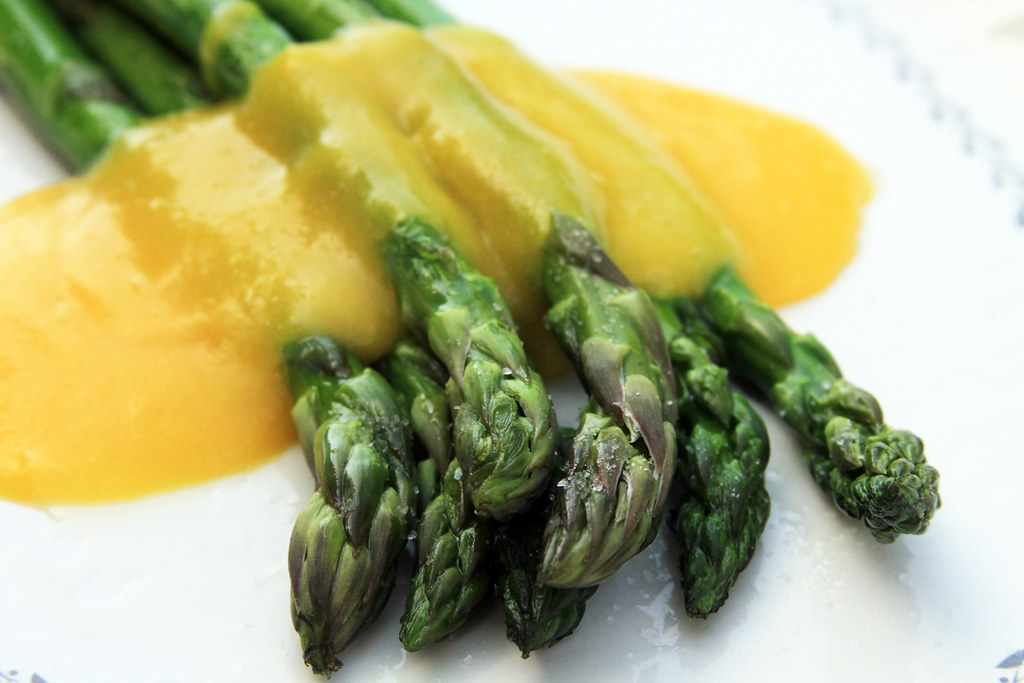Thursday, May 2, 2013
Asparagus with Elderflower Hollandaise
It's mid-spring here, but it's been hot and dry already. There is strength in the green grass yet, but shortly the emerald hills will change to the color of ginger and the constant worry of fire will be here. For now, I sleep with the windows open and relish the nightly delta breeze tickling my back. I try to engrave the feeling in my mind so that I can call it back up when the temperature rises to 110 degrees.
I'm making the most of what I consider 'spring foods' because they aren't going to last long once the sun rises a little higher in the sky.
Elderflower is on, perhaps a little bit early this year. It's abundant in this area which is a good thing, because I enjoy it's delicate floral essence and try to use it often.
Asparagus is abundant too, Asparagus always brings memories of my mother piling it on my plate and admonishing me: 'Asparagus is Jackie Kennedy's favorite vegetable'. Ok, Mom. But don't even come near me with a pillbox hat.
I wanted a way to mix those early spring flavors and naturally my thoughts turned toward Hollandaise and using the sauce to anchor the two foods.
Elderflower is wonderful to work with, but it takes care:
-Pick flowers that are more cream-colored and less green. The green ones have too many unopened buds to add any flavor.
-Make sure that the flowers aren't dropping off the corymbs as you pick it. If they are, it means those particular flowers are too old. Leave them to produce berries.
-Don't pick the flowers and then leave them in your pack for a few hours while you finish you're hike. Bring them home and refrigerate the blooms immediately.
-Don't rinse the flowers prior to using them. You'll wash away a lot of the delicate pollen which is where a lot of flavor comes from. Just shake them gently to get any bugs out. You'll find others as you work the flowers and you can remove them then.
-Remove all the green stems. Don't worry about the tiny white pedicles that hold the flowers, Yes, I know that seems like a chore, but once you get the technique down (sort of hold the blooms between you'r forefinger and middle finger and going snip-snip-snip with the scissors). If you leave the green stems on , they'll add a rank flavor to whatever you're making. Besides, any parts of the elder, other than the flowers and berries are considered toxic.
-When you've cleaned out your bag, you may find quite a bit of pollen clinging to the sides. Add it to whatever you're cooking to increase the 'elderflower' flavor.
As far as a recipe, if you have a favorite Hollandaise recipe, just use that. Simply gently poach a handful or two of cleaned elderflowers in the butter for a few minutes on very low heat. You can sieve out the flowers or not, your choice.
If you don't have a favorite recipe, here's mine:
Simmer 2 handfuls of elderflower (as described above) in 1/2 cup of unsweetened butter.
Whisk 4 egg yolks and a squeeze of fresh lemon juice together in a glass or stainless steel bowl (note that you'll be using this as a double boiler, so make sure it fits in another saucepan), until doubled in volume.
Place the bowl in a pot of simmering water (or use a double boiler if you have one), and continue to whisk the egg mixture constantly. If you let the mixture get too hot, you'll end up with scrambled eggs.
While still whisking, slowly add the infused butter. Whisk until mixture is doubled in volume and then remove from heat.
Whisk in a pinch of salt and cayenne pepper.
You can serve it over asparagus (or on the side) or as Eggs Benedict for a fancy brunch.
Labels:
asparagus,
cooking,
elder,
elderflower,
hollandaise,
recipe,
spring,
wild
Subscribe to:
Post Comments (Atom)

No comments:
Post a Comment